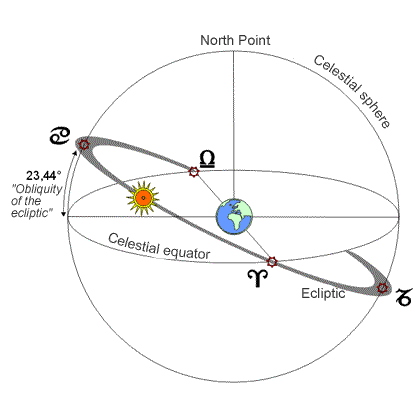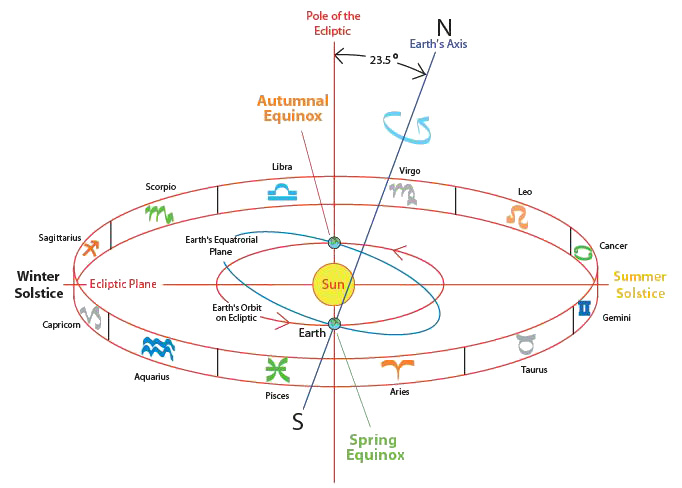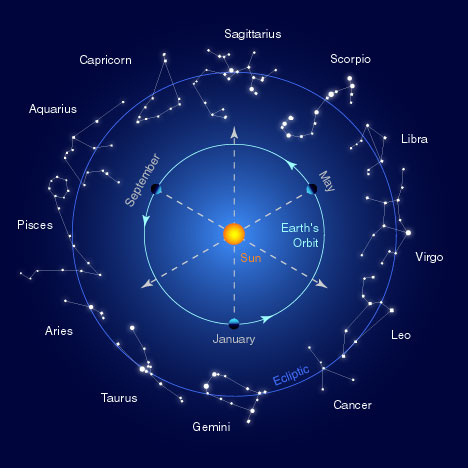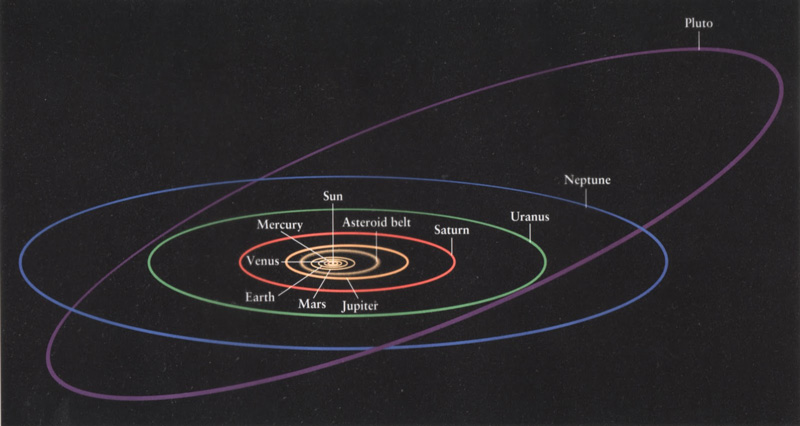The Ecliptic and Sidereal Astrology
- Details
- Written by AndEl

What is the Plane of the Ecliptic?
The plane of the ecliptic (also known as the ecliptic plane) is the plane of the Earth's orbit around the Sun. It is the primary reference plane when describing the position of bodies in the Solar System, with celestial latitude being measured relative to the ecliptic plane. In the course of a year, the Sun's apparent path through the sky lies in this plane. The planetary bodies of our Solar System all tend to lie near this plane, since they were formed from the Sun's spinning, flattened, protoplanetary disk.
The Ecliptic Plane was so named because a Solar eclipse can only occur when the Moon crosses this plane. Its position changes over time, so must be accompanied by an epoch, usually defined as 1950.0 or 2000.0. The ecliptic plane and the celestial equator intersect each other in two diametrical imaginary points called the vernal and autumnal equinoxes. As of 2005, it is at an angle of 23°27’ to the celestial equator, while the inclination of the lunar orbit is approximately five degrees and nine minutes. The moon is inclined to the plane by five degrees.
By definition, the plane of the ecliptic and the plane of Earth's orbit are the same, and are not fixed or constant. The position of the plane of the ecliptic relative to the invariable plane is altered by gravitational perturbations of the other planets, thus changing the celestial ecliptic and the pole of the ecliptic. The latitude of the stars also change, as the plane of the ecliptic varies in degrees. Using both the plane of the ecliptic and the plane of the Earth's equator, the positions of stars may be defined.
No matter the position of the plane of the ecliptic, the Earth's axis is not perpendicular to it and is always inclined at the same angle to it.
Source Here

The Ecliptic - The Zodiacal Band
By Molly Hall
The ecliptic is the line along which the planets orbit, against the backdrop of the fixed stars. These are also our known constellations of the Zodiac. As it passes through the constellations, the Sun appears to follow along a pathway around the Earth. And in the background, are the constellations of the Zodiac. But it just looks like that from our vantage point. The Earth is actually orbiting around the Sun, and is always at a position on the ecliptic directly across.
What is the ecliptic? It's the set line that follows the planetary movements in a circular path. It allows astrologers and other sky watchers to have a fixed reference point for study. The earliest astrologers tracked the Sun against the Zodiac, and created a starting point where the celestial equator meets the ecliptic.
At one point, the actual constellations matched up with that zero point, but now they don't. Because of the Earth's tilt and its resulting slow wobble, the intersection of the equator and ecliptic go back slightly in degrees each year. The result is that the actual point of intersection is moving backwards through the Zodiac. To make a long story short, the signs that we refer to as points along the ecliptic, don't match up with what's seen through a telescope. In tropical astrology, which is what's practiced most in the West, the 0 degree point of the ecliptic is always the Vernal Equinox, when day and night are equal length.

What is Sidereal Astrology?
Sidereal comes from sidus, the Latin word for star. That's meaningful, because sidereal astrology is a system that sets the ecliptic by the position of the fixed stars, rather than the Vernal Equinox. The actual Zodiac begins earlier each year, which means Aries comes in April. And in this system, if your tropical Sun sign is Aries, you might find out you've been a Pisces all along! This is an area of a lot of confusion and debate, and the interest in sidereal astrology, a system with ancient roots, is growing in the West.
- The actual constellations extend 8 degrees above and below the ecliptic in a 16 degree Zodiac belt.
- To early stargazers, it appeared that the Sun moved against the also in-motion backdrop of the constellations.
- The constellations vary in size, and in some places on the ecliptic, are overlapping.
- All the planets orbit near the ecliptic, except for Pluto, which veers up to 17 degrees away.
- The Greeks used the position of the constellations to divide the ecliptic into twelve sections.
- Each section is 30 degrees, and corresponds to the signs and houses in the 360 degree wheel.
- These 30 degree pieces follow the Zodiac signs, starting with Aries.
- The grid it forms on the ecliptic is used to study the planetary positions, and cast birth charts.
- The point of reference is a time/place on Earth, and observed in relation to the ecliptic and planets moving along it.
- This is possible because the moving ecliptic is a stable reference point, that's fixed-in-motion.
- The birth chart is a snapshot of where the planets were along the ecliptic at that moment in time.
- Since tropical astrology is no longer aligned with the actual star positions, it's said to be more symbolic than an indicator of specific astronomical effects.

Source Here
Liked this article? Dive deeper into personal growth and wellness! Check out CrystalWind.ca for spiritual wisdom or explore AromaWorx.ca for natural well-being tips. Spread the positivity—share this with friends on their happiness journey!
Let’s Chat! Drop Your Thoughts Below! ![]()
©2008-2025 CrystalWind.ca. All rights reserved.
No reproduction without written permission.
Crystal Wind wisdom since 2008—Awaken Your Soul!
#CrystalWind #SpiritualJourney #Awakening #Enlightenment
Latest Articles
Dive into the Mystical World of the Crystal Wind Oracle Deck!
Get All the Enchanting Details Now!
NEW Expanded Boxed Edition!
Now with 58 Cards for Richer Wisdom!

Imagine a world of inspiration and healing, free for all—made possible by YOU!
Donate Now—Ignite the Magic at CrystalWind.ca!

Epilepsy - Finding A Cure
Your donation can make a difference!
Help us find a cure – donate now!
Unlock Your Light: Join Lightworkers Worldwide on CrystalWind.ca!
Follow Us!
Featured This Month
The Season of Lammas
The season of Lammas (also called Lughnasadh) begins on August 1st and conti... Read more
Lughnasadh (Lammas) - The Celtic Harvest Fes…
The Celtic harvest festival on August 1st takes its name from the Irish god ... Read more
Lammas by The Hedgewitch
Although in the heat of a Mid-western summer it might be difficult to discer... Read more
Lugh - Celtic God Of The Sun
The god Lugh was worshiped in Ireland as a deity of the sun. This connection... Read more
Lughnasadh Meditation
The Seventh Sabbat of the Wheel is Lughnasadh. Lughnasadh is celebrated on A... Read more













































